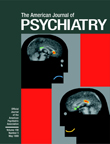To the Editor: We were pleased to see in the article by Harold G. Koenig, M.D., and associates
(1) further rigorous investigation of religiosity as a protective factor in the course of depressive disorder. The results are consistent with our previous findings
(2), drawn from Weissman and associates’ 10-year follow-up study of depressed women
(3), insofar as both studies show religiosity to be highly protective in depressive disorder. In both longitudinal studies, specifically intrinsic religiosity (a personal sense of the importance of spirituality and religion) and not extrinsic religiosity (including frequent attendance of religious services) was found to be protective, which contrasts with some previous cross-sectional studies that have found a protective effect of frequent attendance at religious services against current symptoms of depression
(4).
The two studies involved quite different designs, such that, taken together, they may suggest a breadth to the protective effect of religiosity in the course of depression. Whereas Dr. Koenig’s group found that religiosity hastened remission among moderately depressed patients followed for 1 year, our study found that religiosity protected against recurrence among severely depressed patients followed for 10 years. Subjects in Dr. Koenig et al.’s study were medically ill elderly patients whose depression may have been triggered by the life events of deteriorated health, decreased social functioning, and the prospect of death. Our subjects, by contrast, were mothers (mean age=41 years) of children age 6–18 years facing endemic life events, often with chronic poor social functioning. Dr. Koenig et al. emphasize that their subjects were from the Bible Belt, whereas our subjects were from a predominantly working-class area of New Haven, Conn. These differences between subjects in severity and chronicity of depression, age, clinical status, life events, and surrounding community suggest that religiosity may be broadly protective in the course of depression, buffering against the full life course of negative events in patients with varying depression histories.
The magnitude of the findings in both studies supports the strength of intrinsic religiosity as a protective factor in the course of depression. In Dr. Koenig et al.’s study, remission at the 50-week follow-up was nearly twice as likely among patients who had expressed a high level as compared to a low level of intrinsic religiosity. In our study, among women with a history of major depression, those who claimed that religion is personally highly important as compared to those who did not were 80% protected against a recurrence over 10 years. Taken together, these findings show a protective effect of intrinsic religiosity of roughly the same magnitude as that of selective serotonin reuptake inhibitors.
We hope that the findings from both studies will support future research on the protective effects of intrinsic religiosity on the course of depressive illness.

